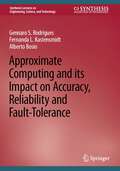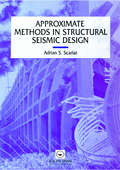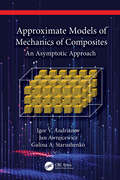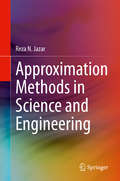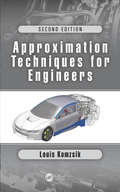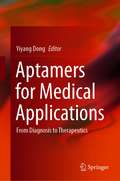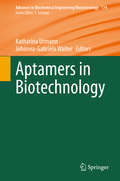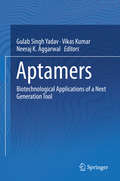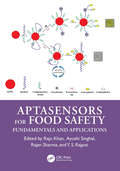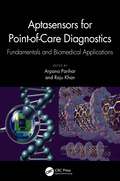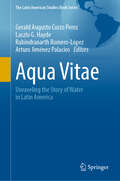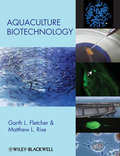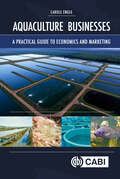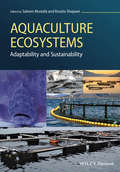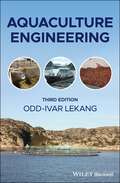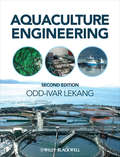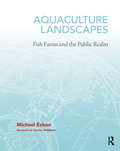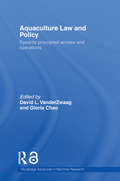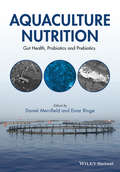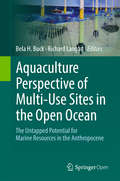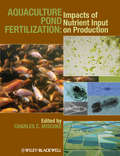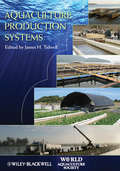- Table View
- List View
Approximate Computing and its Impact on Accuracy, Reliability and Fault-Tolerance (Synthesis Lectures on Engineering, Science, and Technology)
by Alberto Bosio Gennaro S. Rodrigues Fernanda L. KastensmidtThis book introduces the concept of approximate computing for software and hardware designs and its impact on the reliability of embedded systems. It presents approximate computing methods and proposes approximate fault tolerance techniques applied to programmable hardware and embedded software to provide reliability at low computational costs. The book also presents fault tolerance techniques based on approximate computing, thus presenting how approximate computing can be applied to safety-critical systems.
Approximate Iterative Algorithms
by Anthony Louis AlmudevarIterative algorithms often rely on approximate evaluation techniques, which may include statistical estimation, computer simulation or functional approximation. This volume presents methods for the study of approximate iterative algorithms, providing tools for the derivation of error bounds and convergence rates, and for the optimal design of such
Approximate Methods in Structural Seismic Design
by A. ScarlatThis book examines the recent developments in computerized structural analysis and finite element analysis to re-appraise existing approximate techniques and to define their scope and limits more accurately. The book proposes new techniques and provides many numerical examples and comparisons with 'accurate' methods.
Approximate Models of Mechanics of Composites: An Asymptotic Approach
by Jan Awrejcewicz Igor V. Andrianov Galina A. StarushenkoApproximate Models of Mechanics of Composites: An Asymptotic Approach is an essential guide to constructing asymptotic models and mathematical methods to correctly identify the mechanical behavior of composites. It provides methodology for predicting and evaluating composite behavior in various structures, leading to accurate mathematical and physical assessments. The book estimates the error of approximations through comparing asymptotic solutions with the results of numerical and analytical solutions to gain a holistic view of the data. The authors have developed asymptotic models based on mathematical and physical rigorous approaches, which include three-phase models of fibrous composites, a modernized three-phase composite model with cylindrical inclusions, and models of two-dimensional composites of hexagonal structure. Also covered are two-phase models of composites related to the Maxwell formula and a percolation transition model for elastic problems based on the self-consistency method and Padé approximations. By obtaining analytical expressions to effectively characterize composite materials, their physical and geometric parameters can be accurately assessed. This book suits engineers and students working in material science, mechanical engineering, physics, and mathematics, as well as composite materials in industries such as construction, transport, aerospace, and chemical engineering.
Approximation Methods in Science and Engineering
by Reza N. JazarApproximation Methods in Engineering and Science covers fundamental and advanced topics in three areas: Dimensional Analysis, Continued Fractions, and Stability Analysis of the Mathieu Differential Equation. Throughout the book, a strong emphasis is given to concepts and methods used in everyday calculations. Dimensional analysis is a crucial need for every engineer and scientist to be able to do experiments on scaled models and use the results in real world applications. Knowing that most nonlinear equations have no analytic solution, the power series solution is assumed to be the first approach to derive an approximate solution. However, this book will show the advantages of continued fractions and provides a systematic method to develop better approximate solutions in continued fractions. It also shows the importance of determining stability chart of the Mathieu equation and reviews and compares several approximate methods for that. The book provides the energy-rate method to study the stability of parametric differential equations that generates much better approximate solutions.
Approximation Techniques for Engineers: Second Edition
by Louis KomzsikThis second edition includes eleven new sections based on the approximation of matrix functions, deflating the solution space and improving the accuracy of approximate solutions, iterative solution of initial value problems of systems of ordinary differential equations, and the method of trial functions for boundary value problems. The topics of th
Aptamers for Medical Applications: From Diagnosis to Therapeutics
by Yiyang DongThis book outlines comprehensively the main medical uses of aptamers, from diagnosis to therapeutics in fourteen chapters. Pioneering topics covered include aptamer pharmaceuticals, aptamers for malign tumors, aptamers for personalized therapeutics and aptamers for point-of-care testing. The book offers an essential guide for medical scientists interested in developing aptamer-based schemes for better theranostics. It is therefore of interest for not only academic researchers, but also practitioners and medical researchers in various fields of medical science, medical research and bio-analytical chemistry.
Aptamers in Biotechnology (Advances in Biochemical Engineering/Biotechnology #174)
by Johanna-Gabriela Walter Katharina UrmannThis book reviews the development, characterization and applications of aptamers in different areas of biotechnology ranging from therapeutics to diagnostics and protein purification. Hailed as chemical antibodies, these single-stranded nucleic acid receptors were predicted to supersede antibodies in traditional assays, such as ELISA, within a short time. While this has yet to happen, readers will find in this book a deep insight into the progress of aptamer technology and a critical discussion about the limitations that need to be overcome in order to find wider acceptance and use outside of the still relatively small aptamer-community. This book covers all aspects of aptamer generation and application for the aptamer-experienced reader and curious novice alike, with the addition of an industry perspective on the future of aptamer-use in biotechnology.
Aptamers: Biotechnological Applications of a Next Generation Tool
by Vikas Kumar Gulab Singh Yadav Neeraj K. AggarwalThe book discusses the basics of aptamers and the advent of aptamer-based technology in recent times. The book covers the diverse applications of aptamers, such as in detection of animal and plant pathogens, disease diagnosis and therapeutics, environmental contamination detection etc. Besides these applications, the book also describes the use of these synthetic or modified DNA, as drug delivery vehicles.The different chapters describe how the binding capacity and specificity of aptamers can be exploited in various ways. The book also discusses how these attributes of aptamers can outdo the antibody technology in biomedical and diagnostic solutions. This crisp and concise book gives the readers an insight into the most recent biotechnological applications of aptamers.
Aptasensors for Food Safety: Fundamentals and Applications
by Rajan Sharma Raju Khan Ayushi Singhal Y. S RajputThis reference book provides updated knowledge on fundamentals and applications of aptasensorsin food science. It discusses aptamer selection strategies including Systematic Evolution of Ligandsthrough EXponential enrichment (SELEX), Capture SELEX, Cell SELEX, and GO SELEX strategiesfor aptasensor design involving well-studied and newly emerged nanomaterials, food analysisfocusing on its safety, aptasensing techniques relevant to detection of food pathogens, pesticides,veterinary drug residues, toxins, heavy metals, allergens, and future perspectives of aptamers infood science and technology. The book focuses on recent developments in aptasensors and their usein detection of contaminants in food. The book is an excellent resource for R&D organizationsdedicated to the development of biosensors in general and aptasensors in particular for the detectionof environmental contaminants in the food supply chain. Also, the contents of the book willbe useful to researchers, postgraduate students, analytical chemists, food scientists, and regulatoryauthorities.
Aptasensors for Point-of-Care Diagnostics: Fundamentals and Biomedical Applications
by Arpana PariharThe design and fabrication of aptamer-based biosensors for point-of-care testing of disease diagnostic and prognostic is an upthrust and interdisciplinary area of research. This book covers the design and development of novel cost-effective aptamer-based biosensors for disease diagnostic and prognostic including an understanding of health care management in terms of timely updates of disease situations in a particular geographical area. It also discusses the scaling up and market trend of aptamer-based devices for extension of research from lab to market, and end users. Features: Explains the design and fabrication of aptasensors-based diagnostic devices. Includes novel approaches and comprehensive technology overview for diagnosis management towards early-stage detection of various biomarkers associated with several health conditions. Demonstrates possible benefits of combined diagnostics and therapeutic possibilities using aptamer-based point-of-care technologies devices. Discusses emerging implications and recent advances of biosensing platforms for designing and developing aptamer-based point-of-care testing (POCT) devices. Explores aptamer-based approach to develop advanced platforms for medical applications and open arena for state-of-the-art future research. This book is aimed at researchers and graduate students in biomedical engineering, diagnostics, nanobiotechnology, and materials science.
Aqua Shock, Revised and Updated: Water in Crisis (Bloomberg #155)
by Susan J. MarksAn objective look at America's rapidly shrinking water supply Once believed to be a problem limited to America's southwest, water shortages are now an issue coast to coast, from New England to California. In Aqua Shock: The Water Crisis in America, author Susan J. Marks provides a comprehensive analysis of the current conflicts being waged over dwindling water supplies. She presents the findings of university studies, think tanks, and research groups, as well as the opinions of water experts, including Peter Gleick, president of the Pacific Institute for Studies in Development, Environment, and Security. The book Explains where our water comes from and who controls it, as well as the cost of water on cash, commodities, and capitalism Describes the risks of running out of water Details how we can preserve and protect our most precious, yet most undervalued natural resource Right now, battles over water supplies rage across the country. Aqua Shock is an objective look at how we arrived at this crisis point and what we can do-and should be doing-to solve the water crisis in America.
Aqua Vitae: Unraveling the Story of Water in Latin America (The Latin American Studies Book Series)
by Gerald Augusto Corzo Perez Laszlo G. Hayde Rabindranarth Romero-López Arturo Jiménez PalaciosThis comprehensive book presents an analytical journey through the relationship between water and Latin American societies, offering an engineering perspective on historical water resource utilization. The book unravels the integral role water has played in the cultural, technological, and socio-economic development of the region, providing a foundational reference for engineers, academics, and researchers. The book's exploration into water's perception and usage throughout history provides key insights into how human activity has impacted water resources and vice versa. It presents a meticulous examination of water as both a natural and cultural phenomenon, identifying its essential role in sustaining life and ecosystems, as well as its potential for causing devastation through disease and natural disasters. We delve into the complexities of water's role in society, illustrating how it is woven into the fabric of everyday life, religious ceremonies, and global events. The book also underscores the varying significance and implications of water across different regions within Latin America. The narrative unfolds across three major sections: Technology, Water Management, and Socio-Cultural-Economical Impact. The 'Technology' section examines the evolution of water-related technologies and their significant socio-economic implications. The 'Water Management' part offers a holistic perspective on water resource management practices, both historical and contemporary. The final section delves into the societal implications of water use, including conflicts arising from political and economic decisions related to this crucial resource. Designed for engineers, environmental scientists, and policy-makers, this book provides a unique blend of historical context, technical knowledge, and socio-cultural insights. It offers an invaluable resource for those seeking to understand the interplay between engineering practices, water resources, and societal developments in Latin America. It serves as a springboard for further research and informed decision-making in water resource management and policy, fostering a greater understanding of the myriad ways in which water influences and is influenced by human activity.
Aquaculture Biotechnology
by Matthew L. Rise Garth L. FletcherThis important book looks at a broad spectrum of biotech research efforts and their applications to the aquaculture industry. Aquaculture Biotechnology provides key reviews that look at the application of genetic, cellular, and molecular technologies to enable fish farmers to produce a more abundant, resilient, and healthier supply of seafood. Aquaculture Biotechnology is divided into seven sections and nineteen chapters that cover topics ranging from broodstock improvement to fish health and gene transfer. With chapters provided by leading researchers and skillfully edited by top scientists in the field, this will be a valuable tool to researchers, producers, and students interested in better understanding this dynamic field of aquaculture.
Aquaculture Businesses: A Practical Guide to Economics and Marketing
by Carole EngleThis exciting new book provides practical guidance and advice for individuals seeking to manage and develop a successful aquaculture business. Starting with an overview of the challenges faced by aquaculture business operatives, the book then contrasts the different issues faced by new start-up businesses and those that have been in business for many years. The book includes step-by-step guidance and advice on: - how to find key markets, locate customers and determine their preferences; - how to develop estimates of capital requirements for land, construction of buildings and production facilities; - how to purchase equipment; - how to develop a financing plan, including the key financial statements that show early indication of potential problems; - the types of permits and regulations that may be necessary; - delays and costs that can occur from ensuring compliance; - keeping an eye on emerging trends and current consumer preferences; and - monitoring external threats and opportunities. Written by Carole Engle, Aquaculture Businesses is an essential resource for aquaculture entrepreneurs and management-level decision makers for new start-up businesses globally. It is also applicable for existing businesses that need to grow and change with market dynamics. All aquaculture farm owners, and suppliers to the industry, should have this excellent resource to hand. Libraries in all universities and research establishments where aquaculture, business studies, economics or marketing are studied and taught should have copies of this book on their shelves.
Aquaculture Economics and Financing: Management and Analysis
by Carole R. EngleAquaculture Economics and Financing: Management and Analysis provides a detailed and specific set of guidelines for using economic and financial analysis in aquaculture production. By discussing key issues such as how to finance and plan new aquaculture business, how to monitor and evaluate economic performance, and how to manage capital, labor, and business risk, the book equips aquaculture professionals, researchers, and students with important information applicable to a wide range of business decisions. Chapters address each stage of developing an aquaculture business, including financing, marketing, and developing a business plan to managing cash flows and analyzing financial statements. Each chapter includes a detailed example of practical application taken from every-day experience. Written in straightforward terminology facilitating ready application, Aquaculture Economics and Financing: Management and Analysis is an essential tool for analyzing and improving financial performance of aquaculture operations.
Aquaculture Ecosystems
by Saleem Mustafa Rossita ShapawiAquaculture Ecosystems contains a thorough and exciting synthesis of current information on aquaculture practices and substantial discussion of the way forward in transforming the aquaculture industry by improving its sustainability. This important book includes discussion of all the current major issues relating to aquaculture practices in relation to the ecology of their situations, environmental concerns, and details of how sustainability can be improved. Efforts have been made to include chapters that go beyond the stage of debate on old topics, providing conclusions to provide leads for action plans and practices addressing modern challenges such as global climate change. Commencing with a chapter covering concerns and solutions centred around seafood security, the following chapters cover the biology and behavior of aquatic animals and their selection for use in aquaculture systems, integrated multi-trophic aquaculture, nutrient inputs and pollution, biofouling, blue carbon stocks in coastal aquaculture, climate change adaptations and knowledge management in aquaculture. Written by internationally-recognized experts in aquaculture and ecology, and edited by Saleem Mustafa, well known for his work in aquatic sciences, the book provides a great deal of use and interest to all those involved in aquaculture planning and development, environmental sciences and aquatic ecology. All libraries in universities and research establishments where biological sciences and aquaculture are studied and taught should have copies of this vital reference on their shelves.
Aquaculture Engineering
by Odd-Ivar LekangThe revised edition of the comprehensive book that explores the principles and applications of aquaculture engineering Since the publication of the first edition of Aquaculture Engineering there have been many advances in the industry. The revised and thoroughly updated third edition of Aquaculture Engineering covers the principles and applications of all major facets of aquaculture engineering and the newest developments in the field. Written by a noted expert on the topic, the new edition highlights information on new areas of interest including RAS technology and offshore fish farming. Comprehensive in scope, the book examines a range of topics including: water transportation and treatment; feed and feeding systems; fish transportation and grading; cleaning and waste handling; instrumentation and monitoring; removal of particles; aeration and oxygenation; recirculation and water reuse systems; ponds; and the design and construction of aquaculture facilities. This important book: Presents an updated review of the basic principles and applications in aquaculture engineering Includes information on new areas of focus; RAS technology and offshore fish farming Contains a revised edition of the classic resource on aquaculture engineering Continues to offer an authoritative guide written by a leading expert in the field Written for aquaculture scientists and managers, engineers, equipment manufacturers and suppliers, and biological scientists, the third edition of Aquaculture Engineering is the authoritative guide to the topic that has been updated to include the most recent developments in the industry.
Aquaculture Engineering
by Odd-Ivar LekangAs aquaculture continues to grow at a rapid pace, understanding the engineering behind aquatic production facilities is of increasing importance for all those working in the industry. Aquaculture engineering requires knowledge of the many general aspects of engineering such as material technology, building design and construction, mechanical engineering, and environmental engineering. In this comprehensive book now in its second edition, author Odd-Ivar Lekang introduces these principles and demonstrates how such technical knowledge can be applied to aquaculture systems. Review of the first edition: 'Fish farmers and other personnel involved in the aquaculture industry, suppliers to the fish farming business and designers and manufacturers will find this book an invaluable resource. The book will be an important addition to the shelves of all libraries in universities and research institutions where aquaculture, agriculture and environmental sciences are studied and taught.' Aquaculture Europe 'A useful book that, hopefully, will inspire successors that focus more on warm water aquaculture and on large-scale mariculture such as tuna farming.' Cision
Aquaculture Landscapes: Fish Farms and the Public Realm
by Michael EzbanAquaculture Landscapes explores the landscape architecture of farms, reefs, parks, and cities that are designed to entwine the lives of fish and humans. In the twenty-first century, aquaculture’s contribution to the supply of fish for human consumption exceeds that of wild-caught fish for the first time in history. Aquaculture has emerged as the fastest growing food production sector in the world, but aquaculture has agency beyond simply converting fish to food. Aquaculture Landscapes recovers aquaculture as a practice with a deep history of constructing extraordinary landscapes. These landscapes are characterized and enriched by multispecies interdependency, performative ecologies, collaborative practices, and aesthetic experiences between humans and fish. Aquaculture Landscapes presents over thirty contemporary and historical landscapes, spanning six continents, with incisive diagrams and vivid photographs. Within this expansive scope is a focus on urban aquaculture projects by leading designers—including Turenscape, James Corner Field Operations, and SCAPE—that employ mutually beneficial strategies for fish and humans to address urban coastal resiliency, wastewater management, and other contemporary urban challenges. Michael Ezban delivers a compelling account of the coalitions of fish and humans that shape the form, function, and identity of cities, and he offers a forward-thinking theorization of landscape as the preeminent medium for the design of ichthyological urbanism in the Anthropocene. With over two hundred evocative images, including ninety original drawings by the author, Aquaculture Landscapes is a richly illustrated portrayal of aquaculture seen through the disciplinary lens of landscape architecture. As the first book devoted to this topic, Aquaculture Landscapes is an original and essential resource for landscape architects, urbanists, animal geographers, aquaculturists, and all who seek and value multispecies cohabitation of a shared public realm.
Aquaculture Law and Policy: Towards principled access and operations (Routledge Advances in Maritime Research)
by Gloria Chao David L. VanderZwaagThe aquaculture industry is fast expanding around the globe and causing major environmental and social disruptions. The volume is about getting a 'good governance' grip on this important industry. The book highlights the numerous law and policy issues that must be addressed in the search for effective regulation of aquaculture. Those issues include among others: the equitable and fair assignment of property rights; the design of effective dispute resolution mechanisms; clarification of what maritime laws apply to aquaculture; adoption of a proper taxation system for aquaculture; resolution of aboriginal offshore title and rights claims; recognition of international trade law restrictions such as labeling limitations and food safety requirements; and determination of whether genetically modified fish should be allowed and if so under what controls. This book will appeal to a broad range of audiences: undergraduate and postgraduate students, academic researchers, policy makers, NGOs, practicing lawyers and industry representatives.
Aquaculture Nutrition: Gut Health, Probiotics and Prebiotics
by Daniel L. Merrifield Einar RingoManipulation of the microbial gut content of farmed fishes and crustaceans can have a marked effect on their general health, growth, and quality. Expertly covering the science behind the use of prebiotics and probiotics this landmark book explains how the correct manipulation of the gut flora of farmed fishes and crustaceans can have a positive effect on their health, growth rates, feed utilization, and general wellbeing. Aquaculture Nutrition: Gut Health, Probiotics and Prebiotics provides a comprehensive overview of the current knowledge of the gut microbiomes of fish and their importance with respect to host-fish health and performance, providing in-depth, cutting-edge fundamental and applied information. Written by many of the world’s leading authorities and edited by Dr Daniel Merrifield and Professor Einar Ringø, this important book discusses in detail the common mechanisms for modulating microbiomes, particularly at the gut level (e.g. probiotics, prebiotics and synbiotics). The book is a key resource for an understanding of the historical development of these products, their known mechanisms of action and their degree of efficacy as presently demonstrated in the literature. The fundamental material provided on the gut microbiota itself, and more broad aspects of microbe-live feed interactions, provide essential reading for researchers, academics and students in the areas of aquaculture nutrition, fish veterinary science, microbiology, aquaculture, fish biology and fisheries. Those involved in the development and formulation of aquaculture feeds and those with broader roles within the aquaculture industry will find a huge wealth of commercially-important information within the book’s covers. All libraries in universities and research establishments where biological sciences, nutrition and aquaculture are studied and taught, should have copies of this excellent book on their shelves.
Aquaculture Perspective of Multi-Use Sites in the Open Ocean: The Untapped Potential for Marine Resources in the Anthropocene
by Bela H. Buck Richard LanganThis book is open access under a CC BY 4. 0 license. This volume addresses the potential for combining large-scale marine aquaculture of macroalgae, molluscs, crustaceans, and finfish, with offshore structures, primarily those associated with energy production, such as wind turbines and oil-drilling platforms. The volume offers a comprehensive overview and includes chapters on policy, science, engineering, and economic aspects to make this concept a reality. The compilation of chapters authored by internationally recognized researchers across the globe addresses the theoretical and practical aspects of multi-use, and presents case studies of research, development, and demonstration-scale installations in the US and EU.
Aquaculture Pond Fertilization: Impacts of Nutrient Input on Production
by Charles C. MischkePonds are a primary production system to a wide variety of freshwater fish species. Each species have specific and unique nutrient needs and successful pond fertilization is critical to a successful aquaculture enterprise. Aquaculture Pond Fertilization: Impacts of Nutrient Input on Production provides state-of-the-art information for successful fertilization strategies for a broad range of pond-raised species. Aquaculture Pond Fertilization attempts to rectify the seemingly contradictory nutrient recommendations by clearly defining the goals of specific types of aquaculture. Chapters are divided into three sections: The first reviews basic concepts in fertilization applicable to all pond-based production. The second looks at specific nutrient management approaches. The third and final section of chapters looks specifically at key freshwater pond species ranging from tilapia to perch and discusses specific fertilization needs for the successful rearing of these in-demand fish. Looking across species with chapters contributed by leaders in the field Aquaculture Pond Fertilization provides succinct single-volume coverage of an oft-neglected, but vitally important topic in aquaculture production.
Aquaculture Production Systems (World Aquaculture Society Book series)
by James H. TidwellAquaculture is an increasingly diverse industry with an ever-growing number of species cultured and production systems available to professionals. A basic understanding of production systems is vital to the successful practice of aquaculture. Published with the World Aquaculture Society, Aquaculture Production Systems captures the huge diversity of production systems used in the production of shellfish and finfish in one concise volume that allows the reader to better understand how aquaculture depends upon and interacts with its environment. The systems examined range from low input methods to super-intensive systems. Divided into five sections that each focus on a distinct family of systems, Aquaculture Production Systems serves as an excellent text to those just being introduced to aquaculture as well as being a valuable reference to well-established professionals seeking information on production methods.
